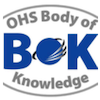Chapter 26: Thermal environment
Abstract
The complex range of hazards associated with the thermal environment is widely acknowledged as a serious Occupational Health and Safety (OHS) issue. Exposure to extreme heat or cold can result in illness, injury and, in extreme cases, death. While highrisk situations will require specialist occupational hygiene advice, the generalist OHS professional should have an understanding of the impact of hot and cold environments, risk assessment methods and the regulatory framework as a basis for advising on, implementing, and monitoring controls. This chapter presents fundamental information about potential health effects, assessment and control methods and, given the relevance of heat exposure to Australian working conditions, outlines a three-tiered approach to the assessment of heat exposure.
Keywords: thermal environment, heat, cold, hypothermia, hyperthermia, burn
First year of publication: 2012
Current Version: 2019
Chapter 26: Physical Hazards - Thermal Environment
Table of contents
| 1 | Introduction |
| 1.1 | Definitions |
| 2 | Historical context |
| 3 | Extent of the problem |
| 4 | Understanding the impact of hot environments |
| 4.1 | Physiological response |
| 4.2 | Acute health effects |
| 4.3 | Chronic health effects |
| 4.4 | Other hazards |
| 4.5 | Risk assessment and assessing the thermal environment |
| 4.6 | Legislation and standards |
| 4.7 | Controls |
| 5 | Understanding the impact of cold environments |
| 5.1 | Health effects |
| 5.2 | Legislation and standards |
| 5.3 | Controls |
| 6 | Contact injuries |
| 7 | Implications for OHS practice |
| 8 | Summary |
| Key thinkers and useful references | |
| References | |
| Appendix 1: Basic Thermal Risk Assessment (informative only) |
Purchase the AUDIO chapter here through AIHS
OR

Dr Ross Di Corleto PhD, BAppSc, GDipOccHyg, MSc,FAIOH, FSIA, COH
Principal Adviser – Industrial Hygiene. RioTinto
Ross first became involved in health and safety in the power generation industry in Victoria over 30 years ago and is currently the Principal Adviser Industrial Hygiene for the Rio Tinto global group, based in Brisbane and an Adjunct Associate Professor at the University of Queensland. Ross was a co-author of the Heat stress standard and documentation developed for use in the Australian environment published by the Australian Institute of Occupational Hygienists. His areas of particular interest include the thermal environment, biological monitoring and Polycyclic Aromatic Hydrocarbons.
Peer Reviewers
Dr David Bromwich, PhD, FAIOH, CIH, COH
Adjunct Associate Professor, Griffith University
Peter Knott, COH Senior Occupational Hygienist, 3M Australia Pty Limited
Learning Outcomes: Thermal environment
The OHS Body of Knowledge takes a conceptual approach which enables it to be applied in different contexts and frameworks. To optimise its value for education and professional development learning outcomes have been developed for each technical chapter in the Body of Knowledge.
The learning outcomes as described give an indication of what should be the capabilities of a new graduate OHS professional in the workplace. I t is up to those developing OHS education programs, OHS professionals planning their CPD or recruiters or employers selecting or developing people for the OHS function to consider the required breadth vs. depth
Videos
SWA Videos: Heat and work injury – panel discussion
An experienced panel of work health and safety experts explore key issues on heat and work injury, including: the importance of developing and adhering to preventative strategies for working in heat, identifying hazards, implementing risk-management strategies, and the need for training and awareness across all levels of management.
Date: 2019
Presenter/s: Panel
Source: https://www.safeworkaustralia.gov.au/media-centre/heat-and-work-injury-prevention-shared-responsibility
Podcasts
3M Science of Safety Podcast – Episode 60 Managing Heat Stress Part 1
Ross describes how the body controls its temperature, defines heat stress and its effect on the body and how to assess the risk.
Date: 2019
Presenter/s: Ross Di Corleto
Source: https://www.3m.com.au/3M/en_AU/safety-au/stories/full-story/?storyid=46ce340b-4b4c-485d-a6f9-bb6cf48efedc
3M Science of Safety Podcast – Episode 60 Managing Heat Stress Part 2
Ross takes the discussion of heat stress further by outlining the controls
Date: 2019
Presenter/s: Panel
Source: https://www.3m.com.au/3M/en_AU/safety-au/stories/full-story/?storyid=2a105791-b6c3-4cfb-9b40-c05b7436caaa
Published 2012 Chapter 26 Thermal Environment

